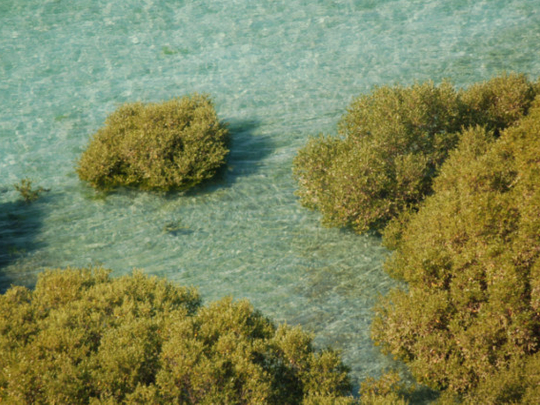
Abu Dhabi: A major portion of a natural wall which protects the capital from possible natural calamities originating from the sea has been saved from destruction thanks to the timely intervention of authorities.
The Environment Agency – Abu Dhabi (EAD) recently succeeded in protecting approximately 60,000 square metres of mangroves on Al Reem Island, an island close to Abu Dhabi City, after learning of a developer’s attempt to clear the area to widen the island’s northern channel. The incident was discovered by EAD’s inspectors who were making a routine visit to the site, the agency has revealed.
The agency stopped a developer’s attempts to remove mangroves to widen the island’s northern channel by approximately 75 metres in order to improve navigation and landscaping related to the channel.
According to the EAD experts, mangroves on the eastern corniche and on the small islands close to Abu Dhabi island guarantee protection of developmental projects on the coastal areas including real estate projects from natural calamities from the sea. The presence of mangroves also mitigates climate change.
It was not the concrete buildings or walls but mangroves withstood the deadly tsunami waves in 2004.
The mangrove also plays an integral role in the marine ecosystem, providing a habitat for aquatic and terrestrial fauna and flora. Although it is one of nature’s important species, mangrove ecosystems can easily be adversely affected due to excessive human activities - such as development, dredging and boat activity.
Engineer Faisal Al Hammadi, Deputy Executive Director, Environment Quality Sector at EAD, said : “This incident — as well as numerous other violations — was discovered when EAD inspectors were making one of their ad-hoc site visits. Working efficiently with the developer, the two teams ceased the mangrove removal operation within a matter of hours. The developer was then asked to submit a mangrove management plan as a mitigation measure, and to provide compensation for the damaged areas which will be used to replant new mangroves in the area,” he said.
Al Hammadi said that before a company can begin developing or dredging the site of its development, it is required to apply for an environmental permit from EAD. Following a stringent application review process and after a license is granted, EAD inspectors regularly visit the site to ensure that the developer is adhering to the conditions stipulated on the permit.
Asked about the penal action taken against the developer for violating the law, an official spokesperson of the agency told Gulf News that the entire operations on the site were stopped. The developer has already submitted the mangrove management plan, the spokesperson said.
Razan Khalifa Al Mubarak, Secretary-General of EAD said: “Our regulatory framework includes a full range of enforcement tools, including: inspections; prosecution and campaigns; an upgrade of our environmental permitting system in line with global best practice, effective implementation of legislation, standards, policy and procedures; undertaking environmental assessments and; industry audits to ensure compliance with legislation.”
According to the International Union for Conservation of Nature (IUCN) Red List, the mangrove species is threatened by the loss of habitat throughout its range, primarily due to extraction and coastal development.












